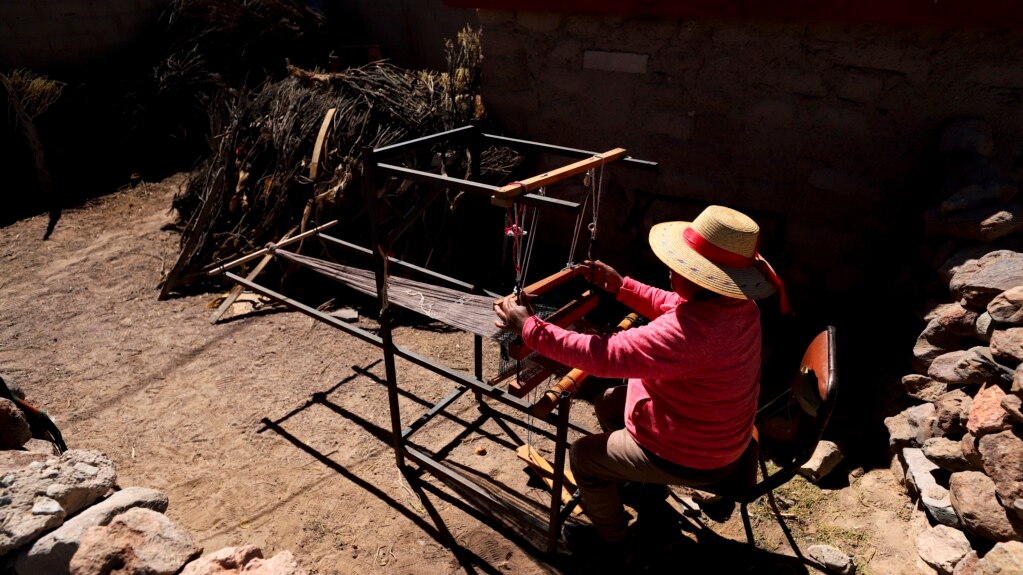In northern Chile, Teófila Challapa learned to weave, or make cloth, surrounded by the high hills and sandy roads of the Atacama Desert.
“Spin the threads, girl,” her grandmother told her fifty years ago.
The 59-year-old Challapa is Aymara, a native South American Indian people. She raises alpacas and llamas. The animals’ hair can be cut off and turned into cloth called wool.
“We had no clothes or money, so we needed to learn how to dress with our own hands,” said Challapa. She lives in Cariquima, a town with fewer than 500 people near the Chile-Bolivia border.
The knowledge of weaving passes from one generation to another, securing Aymara families’ connection with their land.
Challapa prays before beginning her work: “Mother Earth, give me strength, because you’re the one who will produce, not me.”
Among the 3 million Aymaras who live along the borders of Chile, Peru, and Bolivia, the Earth is known as “Pachamama.” Acts to honor Pachamama and asks for Earth’s blessings are a part of everyday life for the people.
“I believe in God, but the Earth provides us with everything,” Challapa said.
Pachamama inspires Challapa’s work in textiles. It provides means for survival, too.
“My animals are my mother,” Challapa said.
Her alpacas and llamas were a source of meat, wool, and emotional support during the difficult years she spent as a single parent raising her children.
Aymara weavers cut off their animals’ wool in October when the weather is warmer. The llamas keep several centimeters of wool to keep them warm and ready for the “floreo.” During this ancient ceremony celebrated in February, Aymaras tie wool flowers to their animals identifying them as their property. They also thank Pachamama for providing them the things they need.
Once the wool is collected and cleaned, the weavers use their fingers to pull threads out of it. The threads are grouped together and placed on a weaving machine called a loom.
Aymara women like Challapa use the money they make from the sale of wool products to send their children to school.
“I thank God because I always told myself: I don’t want them to be like me,” said Marcelina Choque, another woman weaver who lives in the town of Pozo Almonte. “This is my only profession. If I don’t sell, I have nothing.”
Such generational progress comes with mixed emotions, however. “I taught my daughters how to weave just like me, but now that they have other jobs, they don’t weave anymore,” Choque said.
Several woman weavers say the traditional work may end because younger Aymara are moving away from their hometowns. The weavers say there are few young Aymara women who know how to use a loom.
“In rural areas, there is a significant migration of young people, and the population is aging,” said Luis Pizarro, who works at the Agricultural Development Institute of Chile.
The organization supports rural development for Chilean communities connected to the Aymara culture, Pizarro said. The goal is to increase the farming of alpacas and llamas and products through special events and online.
Recently, the Institute held a fashion show inside a shopping center in the city of Iquique. Teófila Challapa, María Choque and other women had their daughters serves as models at the show and sold some of their work.
“We try to get daughters and granddaughters of artisans involved in their cultural inheritance,” Pizarro said.
Nayareth Challapa (no relation to Teófila) speaks proudly about her mother who taught her how to pick the perfect plants for coloring the cloth.
“The colors of our textiles are related to nature: the earth, the sky, the hills. The land is sacred for us,” the 25-year old said. She said the work represents the maker’s emotions as well as the “llamas, flowers and mountains she wants to keep present.”
Nayareth Challapa moved to a city to attend university like so many others. But home is never far from her heart.
“When migrating, many forget their ethnicity and leave their roots behind,” Challapa said. “But my family tries to avoid that.
I’m Gregory Stachel. And I'm Gena Bennett.

